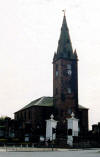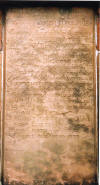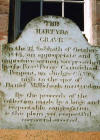|
The Town of Dumfries
|

St. Michael's Bridge |
The River Nith

The
Robert Burns Center |

A New Bridge
|
The River Nith rises and falls
with the Solway tide and flows through the town of Dumfries, about forty miles
east of the Cree. There are plaques on
the sides of St. Michael's Bridge bearing the arms of Dumfries and Maxwelltown.
Dumfries was Robert Burns's home later in his too brief life. An
18th-century watermill houses a museum dedicated to his last years.
A walk from there to St. Michael's Kirk took us to his home church.
St. Michael's Kirk
|
The Kirkyard
|
|
Original Burns Grave
|
| |
|
|
A Christian church has stood on this spot for over 1300 years. On 12
May 1715, Rev. Patrick Linn
was made Minister of Dumfries. Barely a month passed when 6,000
Jacobites went on the march in northern Scotland and a smaller supporting
army appeared not far from Dumfries and stood as though prepared to
attack.
The Lord-Lieutenant of Dumfriesshire gave Rev. Linn the
responsibility of working with his fellow clergymen to maintain a guard
over Dumfries and a neighboring parish. He not only did so but
also took active part in the watch, which continued into October, through
pelting rains and piercing cold. The size of the Jacobite army grew,
but Rev. Linn and the men of the parish had built such defenses and
displayed so much resolve that the Jacobites finally retreated. Rev.
Linn served as Minister of Dumfries from then until his
death in 1731. When the present church building was erected in 1746,
Rev. Linn's
tombstone was moved from its original location and placed in an outside
wall of the building. It reads in part that he preached “in publick with
uncommon eloquence, undaunted courage and impartial freedom to the edification
of many” and was “faithfull in every relation, of a truely Christian spirit ...”
The earthly remains of Robert Burns have been moved
from their original burial spot to a prominent corner of the kirkyard and placed in
a mausoleum, which regrettably we failed to photograph.
From St. Michael's Kirk, we strolled down Burns Street. My
attention was caught by a large white house with the words "Burns House" on its
side. I immediately took a photo. Turning around, we both noticed an elderly man
sitting on a bench across the street, grinning like the Cheshire Cat. I
couldn't imagine what was so amusing. Then I noticed that on the
building I'd just photographed, beneath the words "Burns
House," was an arrow pointing across the street. There was the
real home of the Bard, plaques and all.
The Burns House
Robert Burns died in that home on 21 July 1796, a heart ailment claiming
his life at the age of thirty-seven.
After a few moments, we left the charming
town of Dumfries and drove north through
the River Nith valley.
A mere seventeen miles brought us to the Queensberry Estate and its famous castle.
Elsewhere in the Shire
Drumlanrig
|
Aptly
described as "the Versailles of Scotland", this castle's name means
"fort on the long ridge". Built between 1679 and 1691 on the
site of an earlier Douglas stronghold, its grand architecture and
stately grounds put it in league with the famous French palace.
The surrounding 120,000-acre estate includes a country
park, Victorian gardens, and tenant farms. |

 |
|
Inside the castle, the emblem of a heart
is seen in the structure of a number of rooms, associating the Douglases with Robert
the Bruce. In the 14th century, according to legend, Sir James Douglas
honored his
dear friend and sovereign's dying request by
carrying his embalmed heart in a casket on a crusade to the Holy
Land. Stricken on the way by an enemy's arrow, Douglas
hurled the casket onto the field ahead of him and shouted, "Forward,
brave heart!"
The next four
centuries proved the loyalty of the Douglas clan to the Stewart kings
until, finally, one room at Drumlanrig became an overnight
respite for Prince Charles Edward Stuart. It was 22 December 1745, and
Bonnie Prince Charlie was retreating northward from England with 2,000 of his
Highlanders.
One of several Clan
Douglas castles, Drumlanrig serves in part
as the Dumfriesshire residence of the clan chief - the Duke of Buccleuch and
Queensberry. For that reason, no photographs of
the interior are allowed. However, the architecture,
history, and gardens of Drumlanrig provide a full day of enjoyment.
If you visit, be sure to also enjoy the Tea Room! We did, and then
resumed our travels. Just a mile or two farther north, we arrived at
a grey stone church which seemed picturesque, but we learned it also had a
bit of history. Well, no surprise that.
|
Durisdeer Kirk
In the village of
Durisdeer, on the western edge of the Lowther Hills in Dumfriesshire,
is this fine stone kirk built by the first Duke of Queensberry in the late 17th
century. The Duke and Duchess both are buried at the kirk, but the grave pictured here is that of a martyred Covenanter.
His epitaph consists of two parts on a single stone, the first inscribed in one direction and the
second perpendicular to the first. The
first records the place, cause, and year of his death, along with a
Bible reference. The second
delivers a striking message:
| |
"DANIEL McMICHAEL, MARTYR SHOT DEAD AT DALVEEN BY SIR JOHN DALYEL FOR HIS ADHEREING
TO THE WORD OF GOD CHRIST'S KINGLY GOVERNMENT IN HIS HOUSE: AND THE COVENANTED
WORK OF THE REFORMATION AGAINST TYRANNY PERJURY AND PRELACY. 1685. REV:12·1_
"AS DANIEL CAST WAS IN LYONS DEN FOR PRAYING UNTO GOD AND NOT TO
MEN SO LYONS THUS CRUELLY DEVOURED ME FOR BEARING WITNESS TO TRUTH'S TESTIMONY.
I REST IN PEACE TILL JESUS REND THE CLOUD AND JUDGE TWIXT ME AND THOSE WHO SHED
MY BLOOD."
|
|
Behind the original flat stone is an upright commemorating a memorial
service held 57 years after McMichael's death. More
images of Durisdeer can be seen at:
http://www.undiscoveredscotland.co.uk/durisdeer/durisdeer/index.html.
Leaving Durisdeer, we continued on
our way back to Craigadam, stopping to pick up fish and chips at a
local pub.
|
________________________________________________________________________________________________________________
If you came here from the Bed and Breakfasts page,
use your
browser's back button to return to that page.
If you came from a search, click here to begin at the
beginning :
Home
Contact
|

















